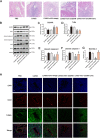SIGIRR-caspase-8 signaling mediates endothelial apoptosis in Kawasaki disease
- PMID: 36600293
- PMCID: PMC9811794
- DOI: 10.1186/s13052-022-01401-8
SIGIRR-caspase-8 signaling mediates endothelial apoptosis in Kawasaki disease
Abstract
Background: Kawasaki disease (KD) is a kind of vasculitis with unidentified etiology. Given that the current diagnosis and therapeutic strategy of KD are mainly dependent on clinical experiences, further research to explore its pathological mechanisms is warranted.
Methods: Enzyme linked immunosorbent assay (ELISA) was used to measure the serum levels of SIGIRR, TLR4 and caspase-8. Western blotting was applied to determine protein levels, and flow cytometry was utilized to analyze cell apoptosis. Hematoxylin eosin (HE) staining and TUNEL staining were respectively used to observe coronary artery inflammation and DNA fragmentation.
Results: In this study, we found the level of SIGIRR was downregulated in KD serum and KD serum-treated endothelial cells. However, the level of caspase-8 was increased in serum from KD patients compared with healthy control (HC). Therefore, we hypothesized that SIGIRR-caspase-8 signaling may play an essential role in KD pathophysiology. In vitro experiments demonstrated that endothelial cell apoptosis in the setting of KD was associated with caspase-8 activation, and SIGIRR overexpression alleviated endothelial cell apoptosis via inhibiting caspase-8 activation. These findings were also recapitulated in the Candida albicans cell wall extracts (CAWS)-induced KD mouse model.
Conclusion: Our data suggest that endothelial cell apoptosis mediated by SIGIRR-caspase-8 signaling plays a crucial role in coronary endothelial damage, providing potential targets to treat KD.
Keywords: Apoptosis; Caspase-8; Endothelial cell; Kawasaki disease; SIGIRR.
© 2023. The Author(s).
Conflict of interest statement
None.
Figures






Similar articles
-
Cathelicidin (LL-37) causes expression of inflammatory factors in coronary artery endothelial cells of Kawasaki disease by activating TLR4-NF-κB-NLRP3 signaling.Immun Inflamm Dis. 2023 Sep;11(9):e1032. doi: 10.1002/iid3.1032. Immun Inflamm Dis. 2023. PMID: 37773705 Free PMC article.
-
Hesperidin alleviates endothelial cell inflammation and apoptosis of Kawasaki disease through inhibiting the TLR4/IĸBα/NF-ĸB pathway.Chem Biol Interact. 2025 Apr 25;411:111445. doi: 10.1016/j.cbi.2025.111445. Epub 2025 Feb 21. Chem Biol Interact. 2025. PMID: 39987982
-
IL-37b alleviates endothelial cell apoptosis and inflammation in Kawasaki disease through IL-1R8 pathway.Cell Death Dis. 2021 Jun 3;12(6):575. doi: 10.1038/s41419-021-03852-z. Cell Death Dis. 2021. PMID: 34083516 Free PMC article.
-
Autoimmune Aspects of Kawasaki Disease.J Investig Allergol Clin Immunol. 2019;29(4):251-261. doi: 10.18176/jiaci.0300. Epub 2018 Sep 5. J Investig Allergol Clin Immunol. 2019. PMID: 30183655 Review.
-
The Future of Kawasaki Disease Diagnosis: Liquid Biopsy May Hold the Key.Int J Mol Sci. 2024 Jul 24;25(15):8062. doi: 10.3390/ijms25158062. Int J Mol Sci. 2024. PMID: 39125631 Free PMC article. Review.
Cited by
-
Impact of intravenous immunoglobulin treatment on peripheral blood cells in children with Kawasaki disease complicated with coronary artery lesion.Ital J Pediatr. 2025 Feb 11;51(1):44. doi: 10.1186/s13052-025-01891-2. Ital J Pediatr. 2025. PMID: 39934855 Free PMC article.
-
Clinical significance of caspase-1 in coronary artery lesions in Kawasaki disease and its mechanism of action on vascular smooth muscle cells.Postepy Dermatol Alergol. 2025 Feb;42(1):96-104. doi: 10.5114/ada.2024.145459. Epub 2024 Dec 3. Postepy Dermatol Alergol. 2025. PMID: 40114775 Free PMC article.
-
Cathelicidin (LL-37) causes expression of inflammatory factors in coronary artery endothelial cells of Kawasaki disease by activating TLR4-NF-κB-NLRP3 signaling.Immun Inflamm Dis. 2023 Sep;11(9):e1032. doi: 10.1002/iid3.1032. Immun Inflamm Dis. 2023. PMID: 37773705 Free PMC article.
-
SIGIRR: An Orphan Receptor Mediating Anti-inflammatory Actions.Expert Rev Mol Med. 2025 Jun 30;27:e24. doi: 10.1017/erm.2025.10009. Expert Rev Mol Med. 2025. PMID: 40583347 Free PMC article. Review.
References
-
- He M, Chen Z, Martin M, Zhang J, Sangwung P, Woo B, Tremoulet AH, Shimizu C, Jain MK, Burns JC, Shyy JY. MiR-483 Targeting of CTGF Suppresses Endothelial-to-Mesenchymal Transition: Therapeutic Implications in Kawasaki Disease. Circ Res. 2017;120:354–365. doi: 10.1161/CIRCRESAHA.116.310233. - DOI - PMC - PubMed
-
- Chu M, Wu R, Qin S, Hua W, Shan Z, Rong X, Zeng J, Hong L, Sun Y, Liu Y, Li W, Wang S, Zhang C. Bone Marrow-Derived MicroRNA-223 Works as an Endocrine Genetic Signal in Vascular Endothelial Cells and Participates in Vascular Injury From Kawasaki Disease. J Am Heart Assoc. 2017;6:1–14. doi: 10.1161/JAHA.116.004878. - DOI - PMC - PubMed
MeSH terms
Substances
Grants and funding
LinkOut - more resources
Full Text Sources
Medical

